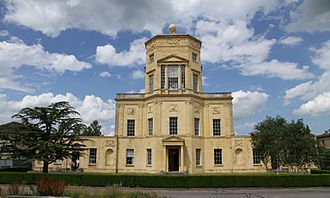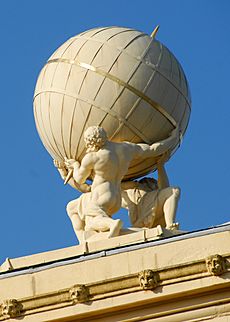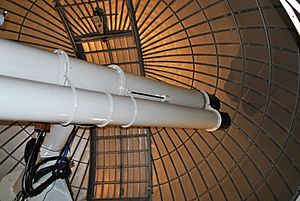Radcliffe Observatory facts for kids
Quick facts for kids Radcliffe Observatory |
|
|---|---|

South front of the observatory
|
|
| General information | |
| Type | Former observatory |
| Architectural style | Neoclassical |
| Location | Woodstock Road, Oxford |
| Coordinates | 51°45′39″N 1°15′50″W / 51.7608°N 1.2639°W |
| Construction started | 1772 |
| Completed | 1794 |
| Owner | Green Templeton College |
| Design and construction | |
| Architect | Henry Keene and James Wyatt |
| Designations | Listed Grade I |
The Radcliffe Observatory was a special building in Oxford, England. It was used by the University of Oxford to study stars and planets. This happened from 1773 until 1934.
Later, the people in charge, called the Radcliffe Trustees, sold the observatory. They built a new one far away in Pretoria, South Africa. Today, the original building in Oxford is part of Green Templeton College. It is a very important historical building, known as a Grade I listed building.
Contents
History of the Observatory

The Radcliffe Observatory was created by the Radcliffe Trustees. They named it after John Radcliffe, a famous doctor. The idea for the observatory came from an astronomer named Thomas Hornsby. He was a professor of astronomy at the university.
In 1769, Thomas Hornsby watched a special event. This was the transit of Venus, where the planet Venus passed in front of the Sun. He watched it from a room in the nearby Radcliffe Infirmary. After this, he suggested building a proper observatory.
Building the observatory started in 1772. The first designs were by Henry Keene. The building was finished in 1794, with new designs by James Wyatt. It has a unique octagonal (eight-sided) tower. This tower looks like the ancient Tower of the Winds in Athens, Greece. On top of the tower, there is a statue made by John Bacon. It shows Atlas, a giant from Greek myths, holding up the world.
Until 1839, the main astronomy professor was in charge of the observatory. But then, a new role was created: the Radcliffe Observer. This happened because the new professor, George Henry Sacheverell Johnson, did not have much experience observing stars.
Why the Observatory Moved
Over time, observing stars in Oxford became difficult. There was too much city development and light pollution. The weather also made it hard to see clearly. Because of these problems, the observatory moved to South Africa in 1939.
The new observatory was built in Pretoria. However, even that location eventually became unsuitable for stargazing. In the 1970s, the Radcliffe Observatory joined with other facilities. Together, they formed the South African Astronomical Observatory (SAAO).
The Observatory Today
The original Radcliffe Observatory building in Oxford is now used by Green Templeton College. It is a central part of the college campus. The old instruments that were used for observing stars are now in the Museum of the History of Science in Oxford.
However, one very important telescope, the Radcliffe 18/24-inch Twin Refractor, was moved. It is now at the University of London Observatory.
Radcliffe Observers
These are the people who held the special job of Radcliffe Observer:
- 1839 Manuel John Johnson
- 1860 Robert Main
- 1879 Edward James Stone
- 1897 Arthur Alcock Rambaut
- 1924 Harold Knox-Shaw
- 1950 David Thackeray
Images for kids
See also
 In Spanish: Observatorio Radcliffe para niños
In Spanish: Observatorio Radcliffe para niños


